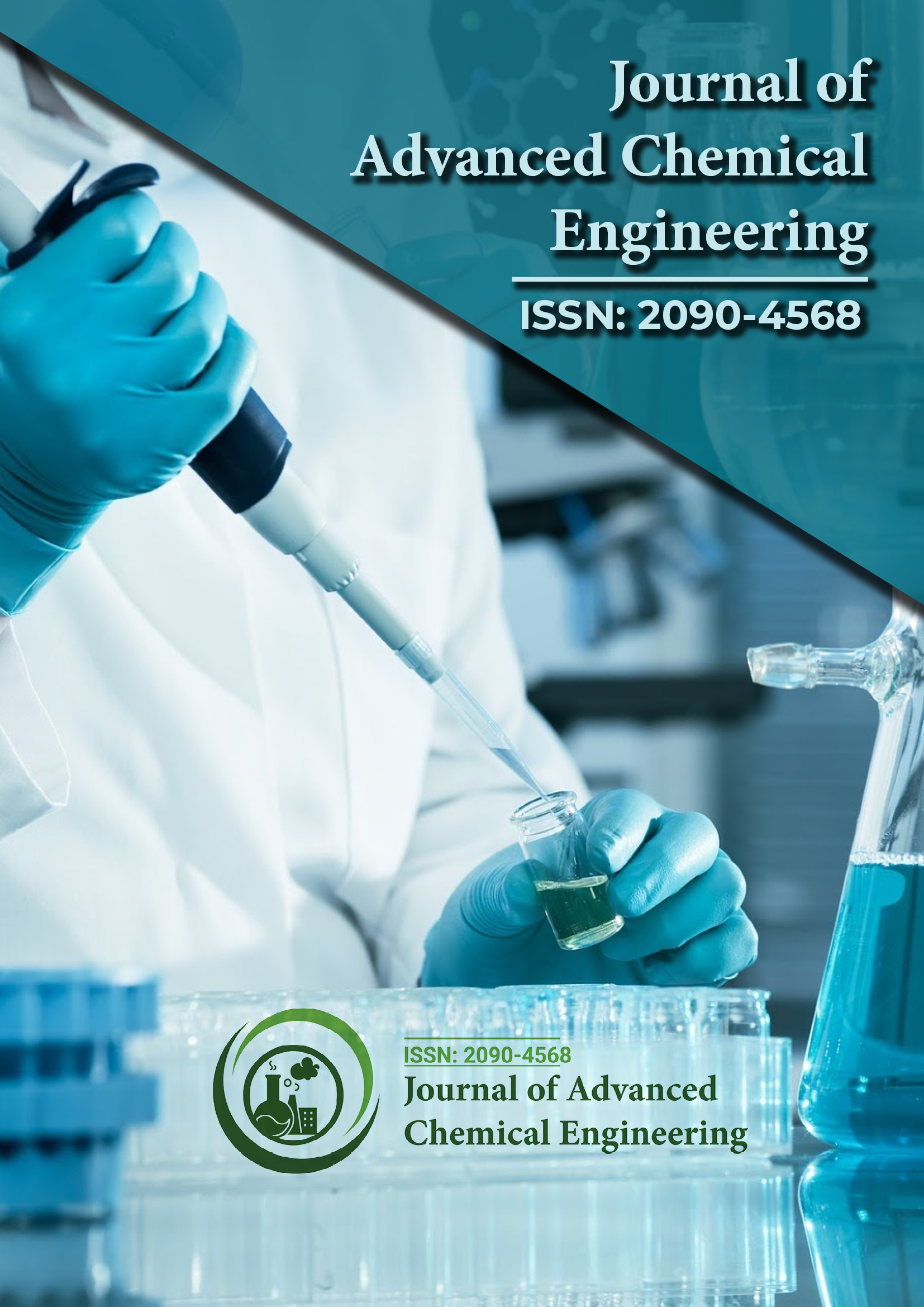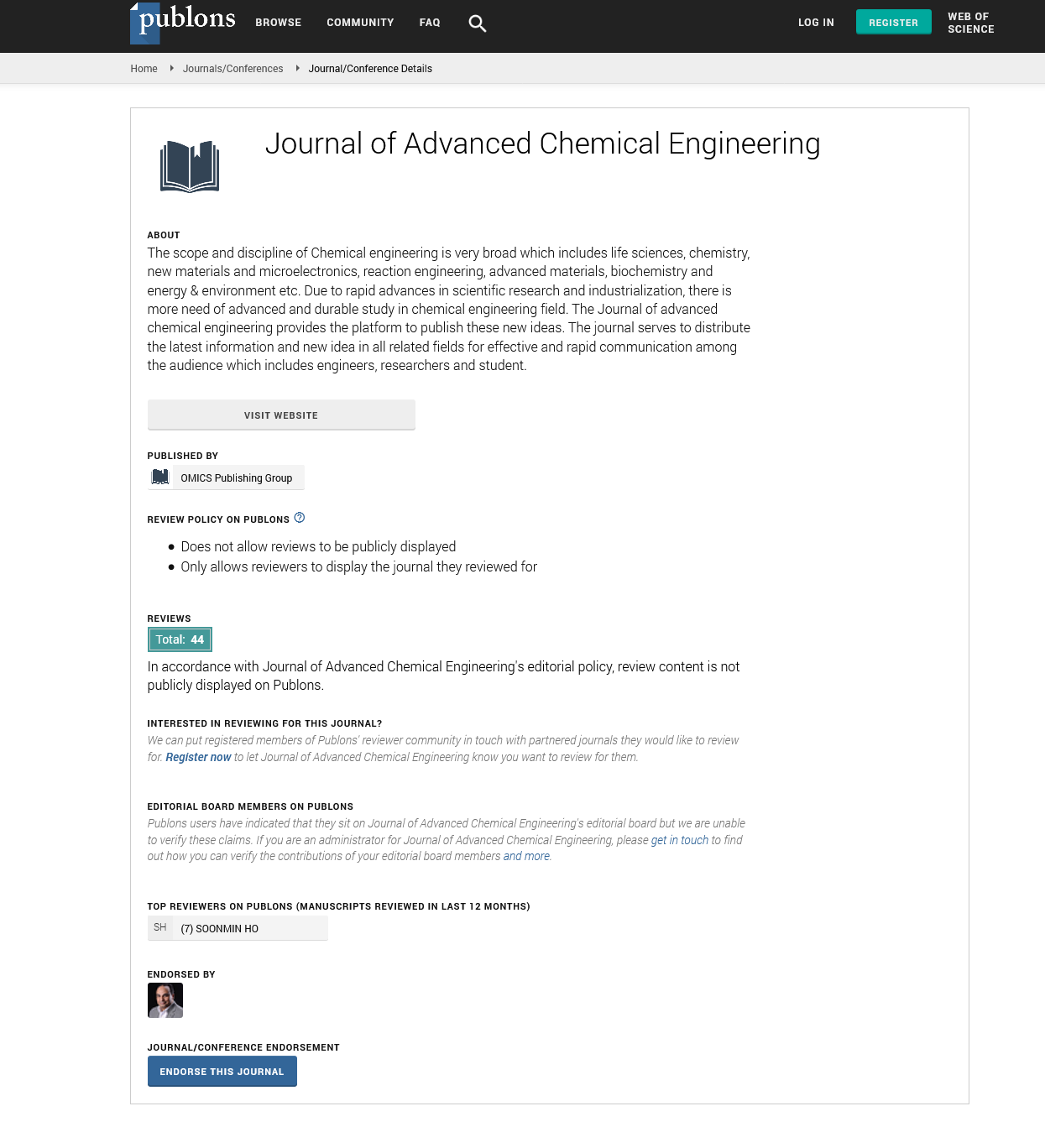Indexed In
- Open J Gate
- Genamics JournalSeek
- Smithers Rapra
- RefSeek
- Directory of Research Journal Indexing (DRJI)
- Hamdard University
- EBSCO A-Z
- OCLC- WorldCat
- Scholarsteer
- Publons
- Geneva Foundation for Medical Education and Research
- Google Scholar
Useful Links
Share This Page
Journal Flyer

Open Access Journals
- Agri and Aquaculture
- Biochemistry
- Bioinformatics & Systems Biology
- Business & Management
- Chemistry
- Clinical Sciences
- Engineering
- Food & Nutrition
- General Science
- Genetics & Molecular Biology
- Immunology & Microbiology
- Medical Sciences
- Neuroscience & Psychology
- Nursing & Health Care
- Pharmaceutical Sciences
Perspective - (2025) Volume 15, Issue 1
Supercritical Fluids in Green Chemical Processing: Opportunities and Limitations
Daniel Hofmann*Received: 03-Mar-2025, Manuscript No. ACE-25-29154; Editor assigned: 05-Mar-2025, Pre QC No. ACE-25-29154 (PQ); Reviewed: 19-Mar-2025, QC No. ACE-25-29154; Revised: 26-Mar-2025, Manuscript No. ACE-25-29154 (R); Published: 02-Apr-2025, DOI: 10.35248/2090-4568.25.15.358
Description
The chemical industry is under increasing pressure to adopt environmentally benign practices that reduce waste, minimize energy consumption, and eliminate the use of hazardous solvents. In this context, Supercritical Fluids (SCFs) have emerged as a promising solution for green chemical processing. Defined as substances above their critical temperature and pressure, SCFs exhibit unique properties that lie between those of gases and liquids, offering exceptional solvation power, tunable density, and enhanced mass transfer characteristics. Among them, supercritical Carbon Dioxide (scCOâ??) has garnered particular attention due to its low cost, non-toxicity, and availability.
Supercritical fluids have been investigated extensively for their role in extraction, reaction, separation, and material processing. Their most well-known application is in the decaffeination of coffee and tea, where scCOâ?? selectively removes caffeine while preserving flavor compounds. Beyond food and beverage industries, SCFs are now increasingly employed in chemical synthesis, polymer processing, and pharmaceutical manufacturing. These applications benefit from the fluid’s ability to dissolve nonpolar and moderately polar substances, as well as from the fact that it leaves no toxic residues after depressurization.
In chemical synthesis, SCFs act as alternative reaction media capable of enhancing selectivity, rate, and product purity. For instance, hydrogenation reactions in scCOâ?? have demonstrated improved conversion and minimized by-product formation. The diffusivity of hydrogen in scCOâ?? and its compatibility with supported metal catalysts like palladium and platinum allow for effective interactions between gas and reactants. Moreover, scCOâ?? enables easy separation of products from catalysts and solvents, which is particularly valuable in pharmaceutical applications where product purity is paramount.
The use of supercritical fluids in polymerization has also opened new pathways in material science. Traditional polymerization techniques often suffer from issues related to heat removal, solvent disposal, and control over molecular weight distribution. In contrast, supercritical emulsion polymerization allows better control over particle size and morphology without the use of harmful surfactants. Additionally, polymers synthesized in SCFs tend to exhibit higher crystallinity and improved mechanical properties due to the uniform conditions during formation.
Another remarkable feature of supercritical fluids is their ability to act as antisolvents. In the Supercritical AntiSolvent (SAS) process, scCOâ?? is used to precipitate solutes from organic solutions, enabling the formation of micro- and nano-sized particles. This technique is particularly useful in drug formulation for enhancing solubility and bioavailability. SAS processes are scalable and reproducible, offering potential advantages over conventional spray drying or freeze drying.
Despite the many benefits, the widespread industrial adoption of SCFs is not without limitations. One of the key challenges lies in the high operating pressures required to maintain supercritical conditions. For example, COâ?? becomes supercritical above 31.1° C and 7.38 MPa, while water requires even more extreme conditions (374°C and 22.1 MPa). These parameters necessitate the use of specialized equipment made of corrosion-resistant alloys, which increases capital and maintenance costs. Furthermore, safety concerns related to pressurized systems must be carefully addressed through robust design and operational protocols.
The solvent power of SCFs, though tunable, remains limited for highly polar or ionic compounds. Researchers have attempted to overcome this limitation by adding co-solvents such as ethanol or methanol to expand the solubility range. However, the introduction of co-solvents reintroduces issues of toxicity and separation that SCFs were initially meant to resolve. Ongoing research is focused on developing task-specific fluids and deep eutectic solvents that could mimic SCF behavior while retaining greener profiles.
From a thermodynamic perspective, modeling phase behavior in supercritical systems remains complex. The non-ideal behavior of SCFs, especially in multi-component systems, requires accurate equations of state and experimental validation. Moreover, scale-up of supercritical processes poses additional challenges related to flow dynamics, heat transfer, and phase transition control.
Citation: Hofmann D (2025). Supercritical Fluids in Green Chemical Processing: Opportunities and Limitations. Adv Chem Eng. 15:358.
Copyright: © 2025 Hofmann D. This is an open-access article distributed under the terms of the Creative Commons Attribution License, which permits unrestricted use, distribution, and reproduction in any medium, provided the original author and source are credited.

